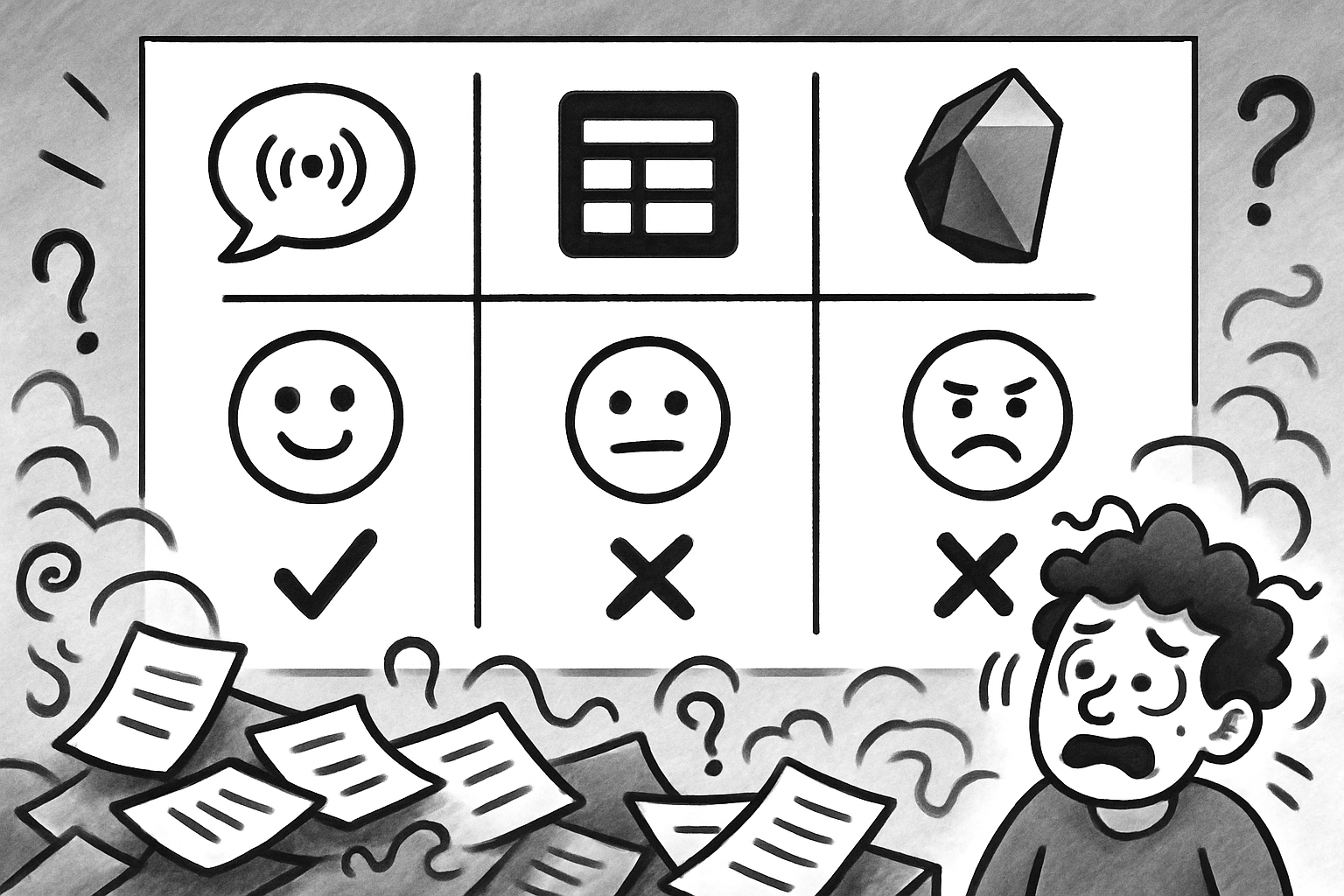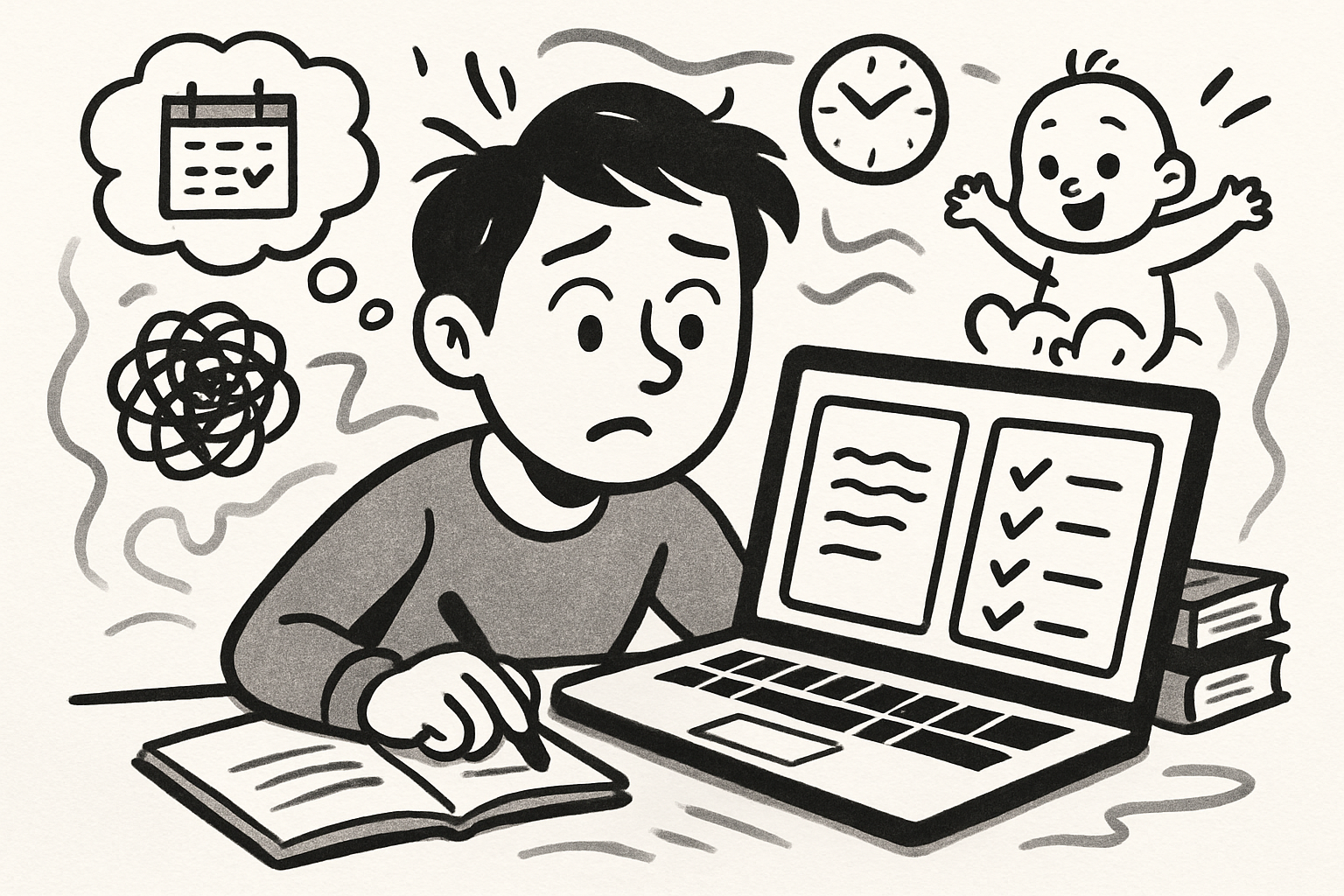Yaranga vs. Obsidian for Real Lives
A comprehensive comparison of Yaranga and Obsidian for users with ADHD, anxiety, or multitaskers. Discover which PKMS turns personal chaos into a system with zero effort.

For overwhelmed minds—whether you're juggling ADHD, anxiety, or just the chaos of a multitasking-heavy life—the promise of a Personal Knowledge Management System (PKMS) or "second brain" is a lifeline. But here's the hard truth: many popular tools can become part of the problem. While powerful, platforms like Obsidian often demand significant effort to build and maintain, a hurdle that can easily lead to "productivity paralysis." This showdown compares this titan with Yaranga, a tool built on a different philosophy: turning your personal chaos into an organized system without any effort. We'll explore which tool truly delivers clarity and calm for the unique needs of real, overloaded lives.
The Unique Needs of ADHD, Anxious Brains, and Overwhelmed Multitaskers
Living with a brain that's constantly buzzing means facing unique challenges. Recent research in attention and cognitive studies shows that adults with ADHD are significantly more likely to experience challenges in time management and organization compared to their neurotypical peers. Common pain points include:
Difficulty with executive functions like task initiation and prioritization
Battling persistent information overload
Feeling frozen by analysis paralysis
Struggling with maintaining organized systems
The goal isn't just to find a place to store notes; it's to find a system that doesn't demand more energy than you have to give. Current research in digital wellness indicates that adults with ADHD report significant improvements in daily productivity when using tools specifically designed for their cognitive patterns.
This is why traditional tools, especially those celebrated for their infinite customizability, can backfire. Recent studies in digital productivity research confirm that participants who used ADHD-specific applications experienced substantial improvements in task completion rates. As productivity experts note, a complex PKMS can "just cause stress," leading users to spend more time perfecting the system than actually using it. This cycle of "procrasti-planning" is a well-known trap.
For this audience, the most crucial features in a PKMS are simplicity, automation, and minimal cognitive friction. The tool must be an ally that reduces mental load, not another complex project to manage.
Looking for actionable strategies beyond just tools? Learn 20 expert-backed productivity tips specifically for managing an ADHD brain.
Yaranga: The AI-Powered 'Digital Desk Drawer' for Effortless Organization
Yaranga is positioned as a simple, task-based note-taking app specifically designed for busy minds. It aims to be a "fast, frictionless space to unload thoughts," serving as a digital desk drawer for everything from grocery lists and messy link dumps to client follow-ups and therapy recaps.
Ease of Use & Setup
Yaranga is built on a "no effort" philosophy. You create a new note with a single click, and it lands directly in your Inbox. There's no immediate pressure to create complex folders or hierarchies. The system is designed to let you capture thoughts first and organize later (or let the AI handle it), removing the initial barrier to entry that plagues more complex tools.
Frictionless Capture & AI Automation
This is where Yaranga's unique value shines. It deeply integrates with daily communication channels to capture thoughts the moment they occur. This approach is a stark contrast to Obsidian, which has no built-in AI automation for capture, a key distinction highlighted in recent expert analyses.
Voice-to-Text Integration: You can send voice notes directly from WhatsApp and Telegram. Yaranga automatically transcribes them, uses AI to add relevant tags, and saves them to your workspace, making it effortless to capture fleeting ideas on the go.
Automatic Task Extraction: Simply type tasks using `[ ]` within any note. Yaranga automatically pulls these actionable items out and organizes them for you, eliminating the need for manual sorting or switching to a separate to-do app.
Important-First Prioritization: Mark any task as "Important" with one click to pin it to the top of every list. This simple feature helps you focus on what truly matters without complex tagging systems. The "Today" tab provides a clear, focused view of your daily agenda.
Tired of tasks getting lost in your chats? Learn the exact strategies to turn conversations into actionable to-do lists.
Key Features for Overwhelmed Users
Yaranga is packed with features designed to reduce cognitive load and centralize information:
Email Integration: Forward important emails to `save@yaranga.net`, and they are instantly converted into notes inside a dedicated "Email Project" for easy processing.
Meeting Note-Taking Pro: Connect your Google Calendar to see events alongside your notes and tasks. Yaranga automatically groups recurring meetings into project folders and lets you link notes directly to calendar events, so context is never lost.
Pulse (⌘ E): This command center provides a real-time overview of recent activity, notifications, and favorite notes, minimizing the friction of searching for what you were just working on.
Simple Hashtags: Use tags like `#important` or `#followup` for flexible organization without having to overthink a rigid folder structure.
Yaranga's philosophy is that Clarity = calm. It's your brainspace — a personal tool built for real, overloaded lives.
Obsidian: The Local-First 'Interlinked Knowledge Graph'
Obsidian is a powerful note-taking tool that uses local Markdown files, focusing on creating interconnected notes to build a personal knowledge graph. It's often described as a "thinking tool that builds knowledge," designed for connecting disparate ideas rather than managing projects.
Ease of Use & Setup for Personal Users
Getting started with Obsidian is relatively simple if you're comfortable with Markdown, but harnessing its true power requires a proactive approach and comes with a steeper learning curve than more streamlined apps. The user is responsible for building the intricate web of links between notes and configuring the tool with plugins to create their desired workflow.
Strengths for Personal Use (for specific user types)
Obsidian offers robust features for deep thinkers:
Bi-directional Linking & Graph View: Its core strength lies in connecting thoughts and discovering hidden relationships within your knowledge base. As TheBusinessDive.com concludes, this makes it incredibly powerful for personal note-taking, with significant safety and privacy advantages.
Local-First Storage: Your data is stored in plain text files on your device. This gives users ultimate ownership, privacy, and robust offline access—a massive plus for anyone anxious about data loss or needing to work without an internet connection. As productivity experts note, "if cloud services go down, all the work you've put into your notes over the years could be at risk. Obsidian is just a text editor... You are the one in control."
Extensive Plugin Ecosystem: A vibrant community has built a massive ecosystem of plugins to add functionality like calendars, task tracking, and advanced automation features.
Weaknesses for the Target Audience
The "effort" in Obsidian lies in the meticulous process of building your knowledge graph and researching, installing, and configuring plugins. It's not natively designed for quick task management or collaborative workflows. While its core features are free for personal use, advanced features like sync and publishing require paid add-ons.
Crucially, it lacks the kind of seamless, out-of-the-box integrations that enable effortless capture, such as voice-to-text from messaging apps. For an overwhelmed user, Obsidian can feel like yet another complex "system to build" rather than a ready-to-use solution for their chaos.
Head-to-Head: Feature Comparison for Our Target Audience
Choosing the right tool depends entirely on which friction point you're trying to solve. For overwhelmed brains, the key is minimizing cognitive load and effort. Here's how the two tools stack up on the features that matter most to this audience.
Feature | Yaranga | Obsidian |
|---|---|---|
Frictionless Capture & AI Automation | Best-in-class. Voice-to-text from WhatsApp/Telegram, email forwarding, and AI-powered task extraction/tagging are built-in. | Manual. Input is fast via Markdown, but capture from external apps requires plugins or third-party workarounds. No native AI automation. |
Effortless Organization vs. Manual System Building | Effortless. AI organizes behind the scenes. Notes land in an Inbox, and tasks are automatically surfaced without user effort. | High Effort. The user must proactively create links, folders, and configure plugins to build their knowledge graph. |
Task Management & Prioritization | Built-in and simple. Features like 'Today', 'No Date', and 'Important-First' views provide instant clarity out-of-the-box. | Relies on plugins. Requires finding, installing, and configuring a task management plugin, which may not be seamless. |
Cognitive Load | Designed for Reduction. The entire UX is focused on minimizing clicks, choices, and the need to "manage the system." | High Initial Load. Requires learning Markdown, linking strategies, and plugin management, which can be daunting. |
Integration & Accessibility | Deep and direct. Focuses on daily communication flows (Email, WhatsApp, Telegram, Google Calendar) for effortless input. | Local-first with robust offline access. Syncing is a paid add-on. Integrations are handled through a large ecosystem of community plugins. |
Learning Curve & Maintenance | Very Low. Designed to work immediately with minimal setup. | Medium to High. Requires understanding core concepts and investing time in customization and plugin configuration. |
Exploring Other ADHD-Friendly Tools in 2025
While this comparison focuses on Yaranga and Obsidian, it's worth noting other tools are also making strides in supporting neurodivergent users. Applications like Focus Bear help block distractions to build better habits, while TickTick offers an all-in-one planner with a built-in calendar, habit tracker, and Pomodoro timer for those who need structure.
Others use gamification to encourage focus. Current research in digital wellness shows that gamified apps like Forest, which lets you grow virtual trees by staying on task, can significantly increase user engagement among individuals with ADHD. These tools represent the growing recognition that productivity apps need to be designed with neurodivergent brains in mind.
Conclusion: Which PKMS Truly Transforms Chaos into System with No Effort?
The daily struggle with mental chaos requires a tool that supports, not complicates. For multitasking, anxious, or ADHD minds, the goal is to reduce cognitive load, not add another demanding project to the to-do list.
While Obsidian is an incredibly powerful platform, it is fundamentally a system you have to build. It's the "Knowledge Architect's Toolkit" that demands your time, energy, and meticulous planning to function effectively. For many, it becomes a source of stress in itself.
For the specific goal of "turning personal chaos into a system without any effort," Yaranga stands out as the clear winner. Its core value proposition is built around solving the exact pain points of an overwhelmed brain. By focusing on AI-powered automation, truly frictionless capture (especially its game-changing voice-to-text from chat apps), and a design philosophy dedicated to providing instant clarity, Yaranga eliminates the barriers that make other tools inaccessible.
The "best" PKMS isn't the one with the most features; it's the one that aligns with your brain's unique needs. It's the tool that minimizes friction so seamlessly that it becomes an effortless extension of your mind, finally supporting your productivity journey instead of overwhelming it.
Experience Effortless Organization Now




